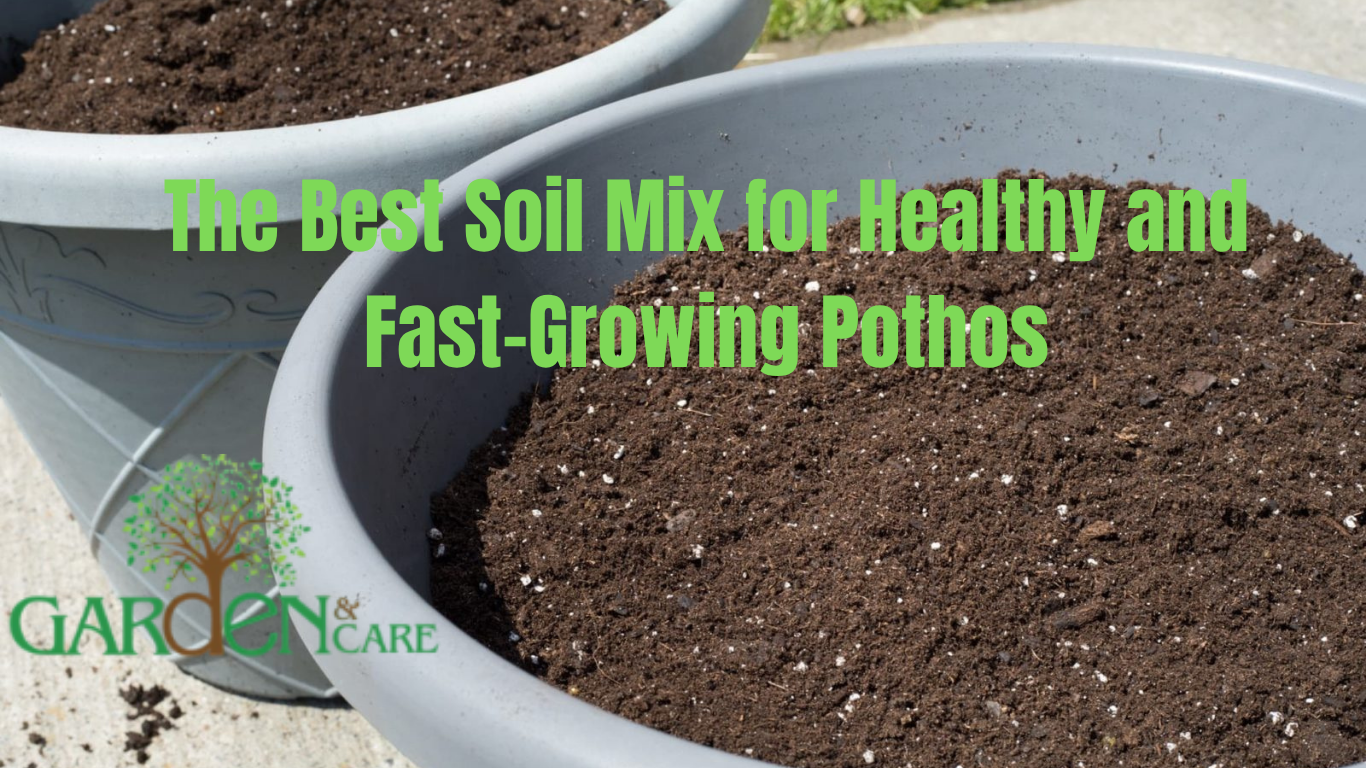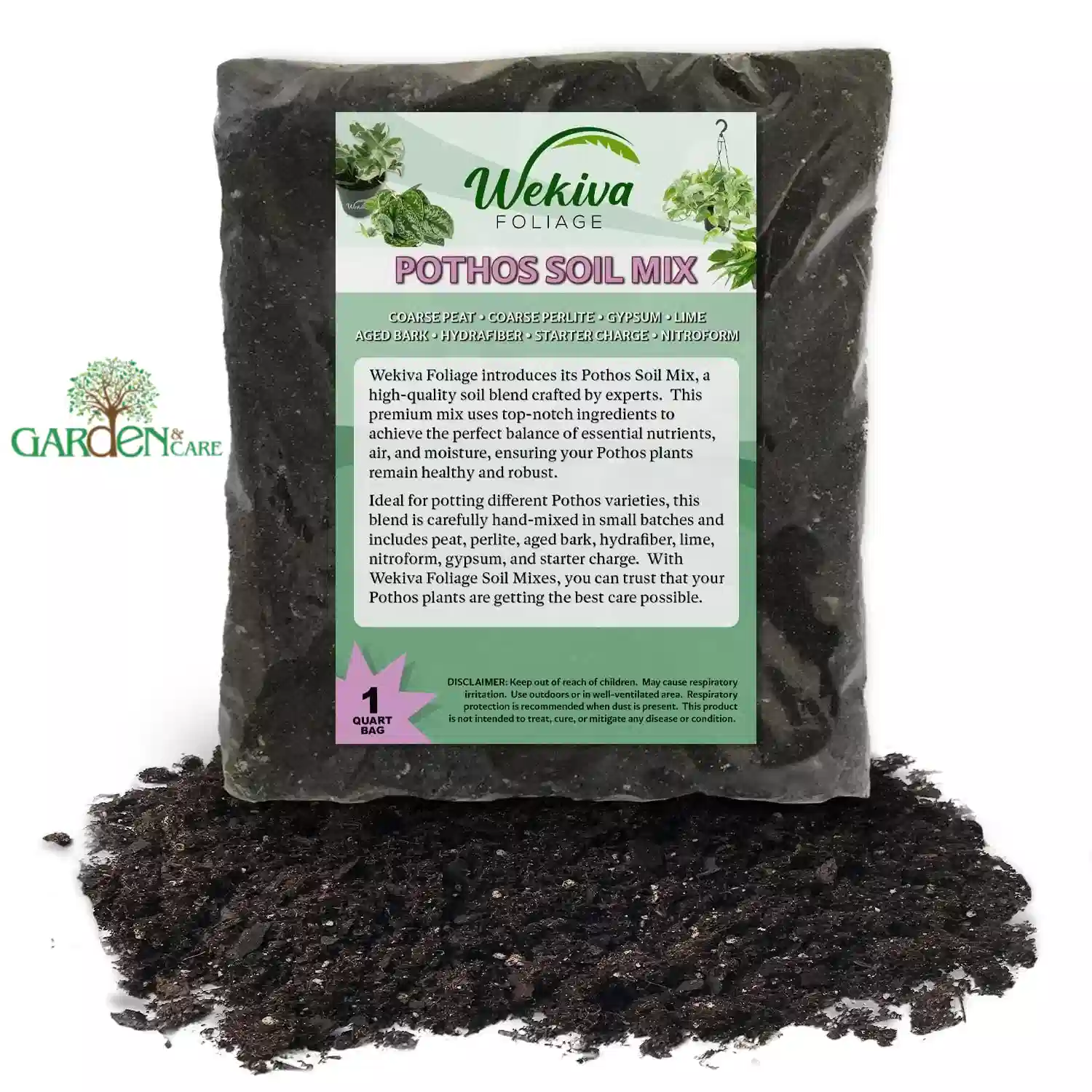Best Soil Mix for Healthy and Fast-Growing Pothos is essential if you want your plant to thrive and grow quickly. Pothos, also known as Devil’s Ivy or the Indian Money Plant, is one of the easiest and most popular indoor plants around the world—especially in homes across Bangladesh, India, and other warm, humid countries. Thanks to its low maintenance needs and air-purifying benefits, it’s perfect for beginners and experienced plant lovers alike
But if you’ve ever noticed slow growth, yellowing leaves, or drooping vines, the problem might be the soil you’re using. Many new plant owners don’t realize that using the wrong potting mix can seriously affect the health of your Pothos.
In this blog, you’ll learn:
- The best soil mix recipe to help your Pothos grow faster and healthier 🌱
- Why each ingredient matters
- Simple tips for watering and sunlight
- How to avoid common mistakes like overwatering or poor drainage
Whether you’re growing your Pothos in a pot, balcony, or indoor corner this guide will help you create the perfect soil foundation for a thriving green plant.
Why Soil Mix Matters for Pothos
Soil isn’t just something to fill a pot it’s the foundation of your plant’s health. For Pothos (also known as Devil’s Ivy or Money Plant), using the right soil mix can make the difference between slow, unhealthy growth and long, vibrant vines full of green leaves.
1. Soil Provides Nutrients, Drainage, and Air
Pothos needs nutrients to grow, just like humans need food. A good soil mix gives the plant:
- Essential nutrients from compost and organic matter
- Proper drainage to remove extra water and prevent soggy roots
- Air flow to roots so they can breathe and stay strong
Without these things, your plant can suffer even if you water it regularly.
2. Poor Soil = Plant Problems
If the soil holds too much water or becomes compacted, it can cause:
- Root rot, a common problem where roots turn black and die
- Yellowing leaves, especially at the bottom
- Stunted growth, where the plant just sits there and doesn’t grow new leaves
This is especially true in humid regions like Bangladesh, India, or Southeast Asia, where overwatering and heavy garden soil are common issues.
3. What Kind of Soil Does Pothos Love?
Pothos loves a mix that is:
- Well-draining (so excess water flows out easily)
- Light and airy (for root breathing)
- Nutrient-rich (to support fast and healthy growth)
That’s why making your own DIY pothos soil mix is better than using plain garden soil or cheap potting soil from the market.
Essential Ingredients for the Best Soil Mix for Healthy and Fast-Growing Pothos
Creating the perfect potting mix for Pothos is easy and the results are worth it! If you want healthy, fast-growing vines, you need a well-balanced blend of materials that support drainage, moisture, and nutrient absorption.
Here are the key ingredients you’ll need for a DIY Pothos soil mix that works in any climate, especially in humid and tropical areas like Bangladesh, India, or Southeast Asia:
🌱 1. Coco Peat (1 Part)
Coco peat is made from coconut husks.
- Holds moisture without making the soil soggy
- Lightweight and eco-friendly
- Helps roots stay hydrated in hot weather
👉 Why it’s great: Keeps your Pothos watered without overwatering.
🪨 2. Garden Soil (½ Part)
Basic garden soil gives structure to the mix.
- Adds minerals and natural bacteria
- Provides some weight and base for root support
👉 Why it’s great: It creates a solid foundation but should be used in moderation to avoid compacting.
🪨 3. Small Stones (½ Part)
Also known as gravel or crushed stones.
- Improves drainage and airflow around the roots
- Prevents water from sitting at the bottom of the pot
👉 Why it’s great: Reduces the risk of root rot by moving water away quickly.
🌑 4. Charcoal Pieces (½ Part)
Use horticultural charcoal, not BBQ charcoal.
- Absorbs toxins and smells
- Prevents fungal growth in damp conditions
- Keeps the soil fresh and clean
👉 Why it’s great: A natural way to fight root disease in humid environments.
🌾 5. Compost (½ Part)
Organic compost (vermicompost or kitchen compost) adds nutrients.
- Boosts leaf color and growth rate
- Feeds your plant slowly over time
👉 Why it’s great: Encourages lush, green foliage with strong roots.
🧪 6. Fungicide Powder (½ Teaspoon)
Optional but highly recommended.
- Protects from root rot and fungal infections
- Especially useful in rainy or humid climates
👉 Why it’s great: Gives your Pothos a strong start by keeping roots healthy.
How to Prepare the Soil Mix
Making your own Pothos soil mix at home is easy and cost-effective. This step-by-step method ensures your plant gets the right texture and nutrients to grow strong, healthy roots and vibrant leaves.
🪴 Step-by-Step Mixing Instructions
To create the perfect soil blend for your Pothos (also known as Devil’s Ivy or Money Plant), follow these steps:
- Gather the Ingredients:
- 1 part coco peat
- ½ part garden soil
- ½ part small stones or gravel
- ½ part charcoal pieces
- ½ part organic compost
- ½ teaspoon fungicide powder (optional, but helpful)
- 1 part coco peat
- Use a Clean Container:
Choose a large tray, bucket, or tub for mixing to avoid spills. - Mix Dry Ingredients First:
Start by combining coco peat, garden soil, charcoal, stones, and compost. Stir them together thoroughly with your hands or a small shovel. - Add Fungicide (Optional):
Sprinkle fungicide powder to prevent fungal growth and root rot, especially in humid regions. - Blend Evenly:
Mix until the texture is even, light, and fluffy.
🧤 Tips to Check Soil Texture
Here’s how to make sure your mix is just right:
- Friable: It should easily break apart in your hand (not sticky or muddy).
- Fluffy: The mix should feel light not compact.
- Breathable: You should see small air pockets or gaps between particles for oxygen flow.
💡 Why it matters: These signs mean your soil has good aeration and drainage, which is key to healthy root development.
🌿 Why This Mix Helps Pothos Grow Fast
This DIY soil mix mimics the natural conditions Pothos loves:
- Excellent Drainage: Prevents overwatering and root rot.
- Moisture Retention: Coco peat keeps roots hydrated without sogginess.
- Air Circulation: Loose particles promote faster root growth.
- Nutrient Boost: Compost provides slow-release food for lush leaves.
Whether you grow your Pothos indoors or on a sunny balcony, this custom mix creates the perfect base for thriving plants 🌱.
🌟 Bonus Tips for Fast-Growing Pothos
Once your soil mix is ready, a few simple care tips can help your Pothos plant grow faster, fuller, and healthier. Let’s look at the key areas: sunlight and watering.
☀️ Sunlight Tips: Give Your Pothos the Light It Loves
Light is one of the most important factors for fast and healthy Pothos growth.
- Ideal Light Condition: Place your Pothos where it can get at least 1 hour of direct morning sunlight or late afternoon sun each day. This gentle light boosts chlorophyll production and encourages leaf growth.
- Bright, Indirect Light: If you can’t give direct sun, the next best option is bright, filtered light near a window.
- Avoid Deep Shade: Low-light areas can cause yellowing leaves, weak stems, and very slow growth. Pothos can survive in low light but it won’t thrive.
🪟 Pro tip: Rotate the pot weekly to help the plant grow evenly on all sides.
💧 Watering Tips: Keep the Roots Happy
Watering Pothos is easy once you learn to read the plant’s signals.
- Water Only When Needed: The safest method is to check the top inch of soil if it feels dry, it’s time to water. You can also look at the leaves: if they’re droopy, the plant is thirsty.
- Don’t Overwater: Soggy soil suffocates roots and leads to root rot, one of the most common problems.
- Things to Consider When Watering:
- Season: In summer, your Pothos may need more frequent watering.
- Humidity: High humidity means less watering is needed.
- Pot Type: Terracotta pots dry out faster than plastic ones.
- Sunlight: Plants in brighter spots dry out more quickly.
- Season: In summer, your Pothos may need more frequent watering.
🚫 Never let the soil stay soggy drainage is key to a healthy Pothos.
❌ Common Mistakes to Avoid When Growing Pothos
Even though Pothos is known as a low-maintenance houseplant, a few common mistakes can lead to slow growth, yellowing leaves, or even plant death. Here’s what to avoid:
1. 🧱 Using Heavy Clay Soil
One of the biggest mistakes is planting Pothos in dense, clay-like soil or regular garden soil without amendments.
- Why it’s a problem: Heavy soil holds too much water and blocks airflow to the roots.
- What to do instead: Always use a well-draining, airy mix with coco peat, compost, and small stones to help the roots breathe and grow fast.
🔑 Search tip: “Best soil drainage for Pothos” is a helpful keyword if you’re researching.
2. 💧 Overwatering or Underwatering
Watering mistakes are one of the top reasons Pothos plants struggle.
- Overwatering causes root rot, black spots, and mushy stems.
- Underwatering leads to dry, crispy leaves and droopy stems.
How to avoid it:
- Always check the top inch of soil before watering.
- Adjust watering based on season, pot type, and light levels.
3. 🌑 Keeping Pothos in Dark Corners
Many people believe Pothos can grow in any light, but that’s a myth.
- Problem: Very low light slows down growth and causes yellowing leaves.
- Fix: Place your plant near a bright window or give it 1 hour of gentle sun daily.
🌿 Remember: Light helps the plant produce energy (chlorophyll) to stay lush and green.
❓FAQs: Soil & Growing Tips for Pothos
🌱 Can I use store-bought potting mix for Pothos?
Yes, you can use store-bought potting mix, but it should be lightweight and well-draining. To improve it:
- Add coco peat or peat moss for moisture control
- Mix in perlite, charcoal, or small stones to improve aeration
- Avoid mixes meant for succulents or heavy clay-based soils
💡 Pro Tip: A customized DIY mix is often better for long-term growth.
🔄 How often should I change or refresh the soil?
Refresh the soil every 12–18 months or when you notice:
- Slow growth
- Foul smell or compacted soil
- Root rot or pests
To refresh:
- Remove old soil from the root zone
- Trim damaged roots
- Refill with a fresh, breathable soil mix
⚖️ Is perlite or vermiculite better for drainage?
For Pothos, perlite is better for drainage and aeration.
- Perlite: Helps keep soil light and airy; perfect for fast-draining needs
- Vermiculite: Holds more water; better for moisture-loving plants but can retain too much water for Pothos
✅ Stick with perlite if your goal is to avoid soggy soil and root rot.
💧 Can I grow Pothos in just water?
Yes, Pothos can grow in water alone! It’s perfect for:
- Small containers or glass jars
- People who want low-maintenance indoor plants
However:
- Change the water every 1–2 weeks
- Add liquid fertilizer monthly
- Keep the jar clean to prevent algae buildup
🪴 Note: Soil-grown Pothos tend to grow faster and bushier over time compared to water-grown ones.
🌿 Conclusion: The Secret to a Thriving Pothos? It’s All in the Soil!
Creating the right soil mix is one of the most important steps in helping your Pothos plant grow fast and stay healthy. A light, airy, and nutrient-rich mix gives the roots room to breathe, drains excess water, and feeds the plant naturally.
By combining simple ingredients like coco peat, compost, garden soil, stones, and charcoal, you can easily make your own DIY Pothos soil that works better than most store-bought options.
✅ Whether you’re a beginner or a plant lover with experience, this soil recipe is easy to follow and gives amazing results.





Leave a Reply